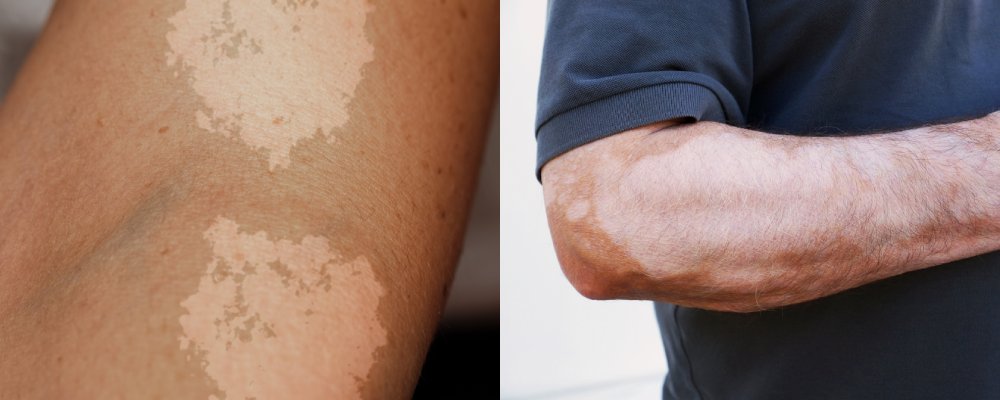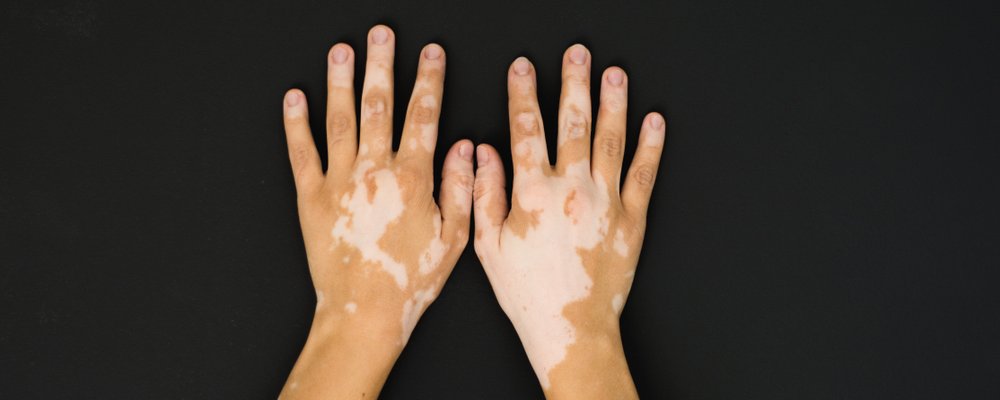Last Updated on August 13, 2025

Introduction
Many skin conditions can cause pigmentation changes. It may lead to confusion between different disorders. Two of the most commonly mistaken conditions are tinea versicolor and vitiligo. While both can result in discolored patches on the skin, they have completely different causes, symptoms, and treatments.
Let’s understand the difference between tinea versicolor and vitiligo in this guide.
What is Tinea Versicolor?

Definition and Causes
Tinea versicolor is a common fungal infection caused by overgrowth of Malassezia. Thus, it is a yeast infection that naturally lives on the skin. If you encounter suitable conditions for the yeast to grow, like excessive heat, humidity, or a weakened immune system, under favorable conditions, this yeast can multiply rapidly. This rapid growth leads to rapid disruption of melanin production and leads to uneven skin tone.
Symptoms of Tinea Versicolor
Recognizing tinea versicolor is relatively simple because of its distinct symptoms. The most common signs include:
- Light or dark patches on the skin, usually appearing on the chest, back, neck, and arms.
- Patches that may appear pink, white, brown, or tan.
- Mild itching, especially in humid conditions.
- A slightly scaly texture on the affected areas.
Additionally, these patches often become more noticeable after sun exposure because the fungus prevents normal tanning. As a result, the surrounding skin darkens while the affected areas remain lighter.
Who is at a Greater Risk?
Certain factors increase the likelihood of this disease, and this may include:
- Living in warm, humid climates.
- Having naturally oily skin.
- Sweating excessively.
- Having a weakened immune system.
However, since this condition is caused by a fungus, it is not permanent, and proper treatment can restore normal skin pigmentation.
Diagnosis and Treatment
A dermatologist can diagnose tinea versicolor by examining the affected skin. Moreover, a Wood’s lamp test or potassium hydroxide (KOH) skin scraping may be used for confirmation.
Treatment options include:
- Topical antifungal creams: Over the counter or prescription-strength antifungal creams, such as clotrimazole or ketoconazole, can clear up the infection.
- Medicated shampoos: Selenium sulfide or zinc pyrithione shampoos can help when applied to affected areas.
- Oral antifungal medications: In severe cases, doctors may prescribe fluconazole or itraconazole.
Additionally, tinea versicolor can recur, so preventive measures like keeping the skin dry and avoiding excessive sweating can help manage the condition.
How Can You Manage Tinea Versicolor at Home?
You can treat tinea versicolor on your own in several ways. The most popular (and least expensive) method is to use a selenium-containing dandruff shampoo. In the shower, apply the shampoo to your skin, then wait a few minutes before washing. Additionally, there are several over-the-counter choices. Therefore, take these drugs as prescribed. However, if after a few weeks, you still don’t see any results, get in touch with your doctor. Perhaps a more potent drug is required.
The majority of natural or at-home therapies are not advised by healthcare professionals due to the lack of research on their effects.
What is Vitiligo?

Definition and Causes
Melanocytes, which are the cells that produce skin pigment, are destroyed in vitiligo, a chronic autoimmune disease. Vitiligo is an immune-related disorder in which the body unintentionally targets its cells, in contrast to tinea versicolor, which a fungus causes. Moreover, vitiligo might be due to genetics or other environmental factors.
Want to Be Part of Advancing Vitiligo Treatment?
Join our clinical trial and contribute to groundbreaking research on vitiligo.
Symptoms of Vitiligo
The primary symptom of vitiligo is the appearance of white patches on the skin. These patches may:
- Develop anywhere on the body, including the face, hands, and around the mouth and eyes.
- Grow larger over time and spread to other areas.
- Affects hair, causing premature graying.
- Be symmetrical, appearing on both sides of the body.
Moreover, unlike tinea versicolor, vitiligo patches do not have a scaly texture and do not cause itching.
Who’s at Risk?
Although vitiligo can afflict anyone, it is more prevalent in those who:
- Have vitiligo in your family.
- Possess additional autoimmune conditions, like thyroid problems.
- Suffer from severe stress or injuries to your skin.
Diagnosis and Treatment
A medical evaluation is necessary to diagnose vitiligo, and this evaluation may involve a Wood’s lamp test, a skin biopsy, or blood tests to look for autoimmune markers. Moreover, it is necessary first to identify the type of vitiligo, i.e., segmental or non-segmental.
Furthermore, restoring pigmentation and stopping the immunological progression are the main goals of treatment options:
- Topical corticosteroids: Aid in repigmenting afflicted regions and slowing advancement.
- Inhibitors of calcineurin: Lower skin immune system activation.
- Light therapy, or phototherapy, promotes the formation of melanocytes.
- Healthy melanocytes are transferred to depigmented areas through surgical skin grafting.
- Finally, treatment can help restore some pigmentation and stop the disorder from spreading, even though vitiligo is a permanent condition.
Key Differences Between Tinea Versicolor and Vitiligo
Additionally, to clarify the difference between tinea versicolor and vitiligo, here’s a side-by-side comparison:
| Feature | Tinea Versicolor | Vitiligo |
|---|---|---|
| Cause | Fungal infection (Malassezia) | Autoimmune destruction of melanocytes |
| Appearance | Patches can be light, dark, pink, or tan; may be scaly | Smooth white patches with well-defined borders |
| Itching | Sometimes itchy | Not itchy |
| Progression | Can fluctuate with climate changes | May progressively spread over time |
| Treatment | Antifungal creams, shampoos, oral medications | Immunosuppressants, phototherapy, skin grafts |
How to Tell the Difference Between Tinea Versicolor and Vitiligo?
It might be difficult to differentiate between the two disorders because they both result in changes in pigmentation. Nonetheless, there are a few crucial indicators:
- It is more likely to be tinea versicolor than vitiligo if the areas are scaly and itchy.
- Vitiligo is the most likely cause if the patches are smooth and keep spreading.
- It is tinea versicolor if the problem is improved with antifungal therapy.
- It is more likely to be vitiligo if the problem progresses or spreads despite treatment.
Additionally, a dermatologist can confirm the diagnosis through clinical exams and tests.
When Should You See a Doctor?
If you notice any of such symptoms on your body, consult a physician immediately:
- The patches keep expanding or growing.
- The illness is not improved by over-the-counter antifungal medications.
- Other symptoms make you suspect an autoimmune disease.
Additionally, a professional diagnosis ensures the right treatment and prevents unnecessary stress about skin discoloration.
Conclusion
While tinea versicolor vs vitiligo may appear similar at first glance, they have distinct causes, symptoms, and treatments. Tinea versicolor is a fungal infection that can be treated with antifungal medications, whereas vitiligo is an autoimmune condition that requires long-term management.
Additionally, knowing the difference between tinea versicolor and vitiligo is essential for proper care. If you notice changes in your skin’s pigmentation, consult a dermatologist for an accurate diagnosis. With the right treatment approach, both conditions can be effectively managed, helping you maintain healthy, even-toned skin.
Have Questions? We’re Ready to Assist
Contact us for your queries and start your journey towards better health.
